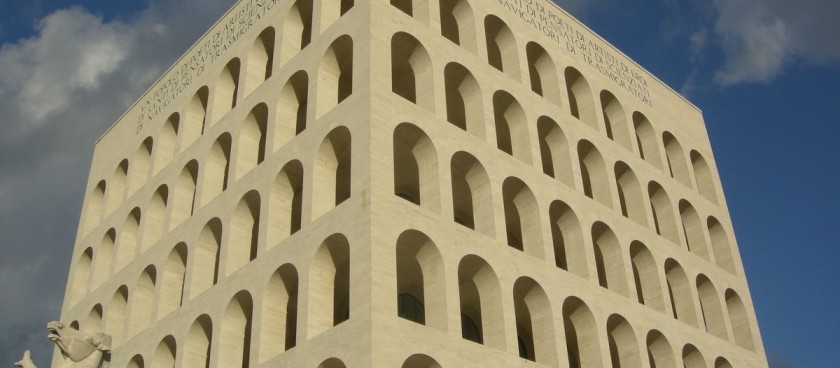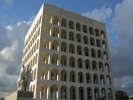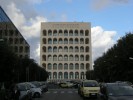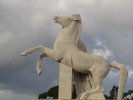-
#Architectural Oddities
The project was originally called E42 after the year in which the exhibition was planned to be held. EUR was also designed to direct the expansion of the city towards the south-west and the sea, and to be a new city centre for Rome.[1] The planned exhibition never took place due to World War II.
Most of the area is the property of EUR S.p.A., a company jointly owned by the Ministry of Economy and the Rome municipality.
History
The complex was planned to be home to a World Fair to celebrate the twentieth anniversary of the March on Rome and of the beginning of the Fascist era. The autonomous agency responsible for organization and construction of the project, E42 (Esposizione 1942), was created on 26 December 1936.
The general commissioner of the agency, Vittorio Cini, presented a list of the most prominent Italian architects available to Mussolini. The list included Adalberto Libera, Enrico Del Debbio, Giuseppe Terragni, Giovanni Michelucci, Eugenio Montuori and Giovanni Muzio. Among the large list, Marcello Piacentini (head of the project), Giuseppe Pagano Pogatschnig, Luigi Piccinato, Luigi Vietti and Ettore Rossi were chosen. The first project, on an area of 4 km2 (1.5 sq mi), was presented in 1938.
The name was later changed to EUR, and the final project was presented in 1939. However the Expo never took place due to the Second World War, and the original project was left uncompleted when the works had to stop in 1942.
During the World War II the uncompleted EUR development suffered severe damage. However, the Roman authorities decided that EUR could be the basis of an out-of-town business district, which other capitals did not begin planning until decades later (for example, London Docklands and La Défense near Paris). Therefore, during the 1950s and 1960s the unfinished Fascist-era buildings were completed and other new buildings were built in contemporary styles for use as offices and government buildings, set in large gardens and parks.
EUR was almost fully completed for the 1960 Olympics, held in Rome. At that time, most of the important infrastructures, such as the Palazzo dello Sport (designed by Nervi and Piacentini) and the Velodromo were completed.
The EUR development agency, founded in 1936, became a Società per Azioni on 15 March 2000[4] and is still responsible for some aspects of management and organization of the area.
After a period of controversy over its architectural and urban planning principles, the project to design EUR was commissioned from the leaders of both of the rival factions in Italian architecture: Marcello Piacentini for the "reactionaries" and Giuseppe Pagano for the "progressives". Each of them brought in their own preferred architects to design individual buildings within the district. EUR offers a large-scale image of how urban Italy might have looked if the Fascist regime had not fallen; wide axially planned streets and austere buildings of either stile Littorio, inspired by ancient Roman architecture, or Rationalism, modern architecture but built using traditional limestone, tuff and marble.
Architecture
The initial project was presented in 1938 under the direction of Marcello Piacentini. The design was inspired, according to the fascist ideology, by Roman Imperial town planning, with modern elements which came from Italian rationalism, the result being a sort of simplified neoclassicism.
The project develops over orthogonal axes and large and stately buildings, built mainly of limestone, tuff and marble, traditional materials associated with Roman Empire architecture.
The most representative building at EUR, and the symbol of this architectural style, is the Palazzo della Civiltà Italiana (1938–1943), an iconic project which has since become known as the "Colosseo Quadrato" (Square Colosseum). The building was designed by Giovanni Guerrini, Ernesto Lapadula and Mario Romano, also inspired by Metaphysical art.
In 1938 Luigi Moretti (with Fariello, Muratori and Quaroni) won the competition for the design of the Imperial Square (now Piazza Guglielmo Marconi). The large building fronting the square was never finished, but after the war the structures already constructed were used for the "Skyscraper Italy (Grattacielo Italia)" by Luigi Mattioni.
Other notable buildings are:
1. Palazzo dei Ricevimenti e dei Congressi;
2. Archivio Centrale dello Stato;
3. Basilica parrocchiale dei Santi Pietro e Paolo;
4. Office palace;
5. INA and INPS palace;
Several museums are also present. These comprise the Museo della Civiltà Romana (Roman Culture Museum), the Museo Nazionale dell'Alto Medioevo (National Museum of the Middle Age) and the Museo Nazionale Preistorico Etnografico Luigi Pigorini (Prehistoric Ethnographic Museum). A new planetarium, connected to the Astronomy Museum, opened in 2004.



